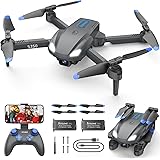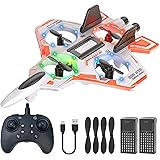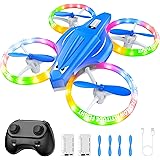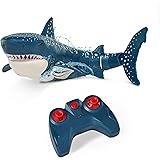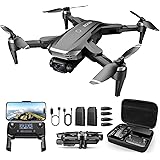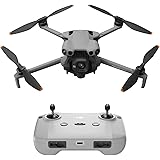Have you ever considered the intricate engineering behind the world’s smallest drone, especially after witnessing the initial flight challenges presented in the video above? While the visual demonstration playfully highlights the immediate, often humorous, difficulties in piloting such a diminutive device, the underlying technology enabling a micro drone of this caliber is a marvel of modern robotics and miniaturization. The excitement of unboxing the world’s smallest drone quickly gives way to the complex reality of mastering its gyroscopic ballet in confined spaces.
Indeed, launching and controlling these ultra-compact aerial vehicles, particularly for indoor flying, demands a specific understanding of their operational nuances. The video showcases a common first experience: a blend of anticipation and erratic flight. However, this initial struggle belies the sophisticated design principles and precision manufacturing involved in creating a UAV that can lift off from the palm of your hand and offer a surprising level of agility, even if a few tumbles are part of the learning curve.
Deconstructing the Micro Drone: Engineering Marvels for Indoor Flying
The development of a truly miniature quadcopter, often referred to as a micro drone, involves overcoming significant engineering hurdles. Unlike their larger outdoor counterparts, these tiny machines operate within tight volumetric constraints, requiring every component to be optimized for size, weight, and power consumption. The inherent instability of such small airframes necessitates advanced flight control algorithms, often leveraging sophisticated accelerometers and gyroscopes to maintain orientation and provide a stable platform for indoor flying.
Consider the power-to-weight ratio: each rotor must generate sufficient thrust from a minimal power source, typically a tiny LiPo battery. This means maximizing propeller efficiency while minimizing motor size and current draw. Moreover, the frame itself must be robust enough to withstand inevitable collisions—hence the necessity for those “extra propellers” mentioned in the video—yet remain incredibly light to ensure responsive flight dynamics and extended flight times, however brief.
Flight Stability in Miniature: The Gyroscopic Advantage
Achieving stable flight with a micro drone is a testament to sophisticated sensor integration and firmware programming. Unlike the human pilot’s initial fumbling, the drone’s flight controller unit (FCU) processes real-time data from integrated MEMS (Micro-Electro-Mechanical Systems) sensors, primarily gyroscopes and accelerometers, at astonishing speeds. These sensors detect minute changes in pitch, roll, and yaw, sending corresponding commands to the brushless or coreless motors hundreds of times per second.
Imagine if this intricate feedback loop were even marginally less precise; the drone would simply flip upon takeoff. Conversely, the advanced algorithms within the FCU constantly compute and adjust individual motor speeds to counteract external disturbances and maintain a level attitude. This computational prowess is critical for an indoor flying drone, where air currents from HVAC systems or even human movement can significantly impact stability, making the precise calibration of these systems paramount.
Propeller Dynamics and Durability: Key to Micro Drone Longevity
The mention of “extra propellers” in the video is a practical acknowledgement of a key vulnerability in micro drone design: the propellers themselves. Despite their diminutive size, these components are subject to immense stress, especially during the learning phase of a new pilot. Made from lightweight yet flexible plastics, they are designed to absorb impact, but continuous collisions, particularly with hard surfaces, will inevitably lead to damage, compromising flight efficiency and stability.
The design of these micro-propellers is a delicate balance of aerodynamics and material science. Each blade is meticulously sculpted to generate maximum thrust for its size and rotational speed, operating at incredibly high RPMs. Furthermore, the motors driving these propellers are often coreless DC motors for ultra-light designs, though more advanced micro drones may incorporate brushless motors for greater efficiency and longevity, albeit at a higher cost and slightly increased weight.
Navigating Confined Spaces: The Art of Indoor Flying
Mastering indoor flying with a compact UAV like the world’s smallest drone transcends mere control stick manipulation; it involves an intuitive understanding of micro-aerodynamics and spatial awareness. The enclosed environment presents unique challenges compared to open-air flight. Air pressure differentials, the proximity of obstacles, and the lack of GPS signal necessitate a reliance on visual cues and the drone’s internal stabilization systems.
Consider the delicate touch required: even a slight overcorrection on the controller can send a tiny drone careening into a wall. Hypothetically, imagine trying to fly a full-sized drone in a broom closet; the principles, scaled down, are similar. Advanced pilots develop a finesse that anticipates the drone’s reaction to control inputs and compensates for minute air disturbances, allowing for precise maneuvers even in cramped living spaces or intricate industrial settings where inspection with a micro drone could be invaluable.
The Evolution of Miniature Robotics: Beyond the Hobbyist
While the video showcases a recreational encounter with a tiny drone, the technological advancements in miniaturized quadcopters have far-reaching implications beyond hobbyist enjoyment. The ability to create a stable, controllable, and autonomous flying platform in such a small form factor opens doors for numerous specialized applications. From intricate inspection tasks in hard-to-reach industrial areas to environmental monitoring in sensitive ecosystems, the potential for a purpose-built micro drone is significant.
Indeed, the progress in reducing the size and increasing the capability of these aerial robots is a continuous frontier in robotics. Imagine if future iterations of the world’s smallest drone could carry microscopic sensors for gas detection or deploy in swarms for coordinated mapping of disaster zones. These devices are not merely toys; they are progenitors of a new generation of highly versatile, compact, and potentially autonomous UAVs, pushing the boundaries of what is possible in aerial robotics.


